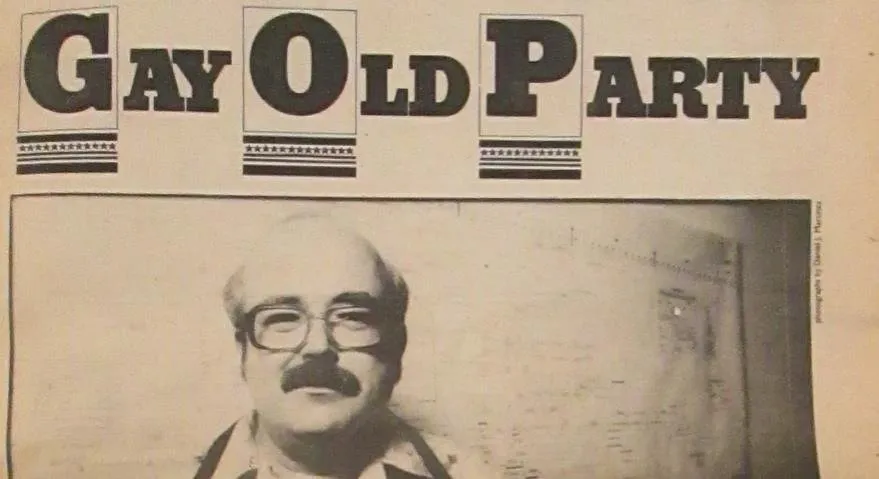This is the first in a series of posts on the intersection of multicultural politics and right-wing sympathies, focusing on the gay right. Other series will take up that broader lens, but focus on other groups like LaVeyian Satanism, and countercultural leaders like Timothy Leary. If there’s a keyword here linking all of this research, it is my interest in a certain aesthetic I associated with these trippy reactionaries, which I call “neo-reactionary psychedelia.” At the core of the work is an abstract concern with what a political spectrum was at the founding of modern liberal-democratic nation-states, what it became in the twentieth century “after the defeat of fascism and communism,” and now, in the comments I hope, what it means now as the nation’s control over its domestic population and economy crumble in the wake of hyperspatial planes of reality augmentation—from Facebook’s and the “fake news” problem to blockchain technology and the very meaning of value. The key parameters of Western democratic nations’domestic politicall spectrums have given way to something akin to a 4D politics. That is the main theme @spectrums on Steemit will be exploring.

Six years after the homphile activists Barabara Gittings and Frank Kameny took the “cognitive revolution” (a post is queued already to narrate this battle, and what cognitivism had to do with ti) to the 1973 Dallas APA, winning the battle against the “sickness theory” of homosexuality which had dominated US legal and medical discourse since the rise of the Welfare state’s, this state form’s normative logics of exclusion being one way modes of sexuality that did not conform to the economic model of Keynesianism, which relied upon productive nuclear families.channelingg a heightened civil libertarianism not quite appreciated by the standard notion of their “retreat to respectability,” to use historian of sexuality John D’Emilio’s seminal phrase as a shorthand for a lasting delicateness in discussing the ersatz right-wing politics in homophile organizing. Quite smartly, given the changing tides of psychological discourse in the cognitive revolution at the dawn of neoliberalism, they allied themselves with Ayn Rand’s ideological döppleganger, the “rationalist” cognitive therapist Albert Ellis—a few years later, with an energized Christian social conservatism uniting Protestants and Catholics on the terrain of reproductive politics (i.e. abortion and homosexuality), and a more diverse menu of political sensibilities and dispositions for gay people, things looked a lot different on the gay right, which was expanding rapidly. By 1980, a new breed of gay reactionary had emerged. “We are the party of the Party,” gay Republican movement insider Frank Ricchiazzi told the Los Angeles Reader in 1980.
Thanks to the newly available records of the first gay Republican organizations in the country—an assortment of organizations that eventually coalesced into the Log Cabin Republicans which makes up the “Log Cabin Tradition,” held by the University of Minnesota Libraries’ Jean-Nickolaus Tretter Collection in Gay, Lesbian, Bisexual and Transgender Studies —we can pin the first blip on the map of gay reactionaries' formal engagement with electoral politics in Los Angeles.

It was April 2nd, 1979, and on display was something more explicitly reactionary, and more explicitly bizarre, than the homophiles' often libertarian “respectability politics," which was an often reasonable strategy of style, a response wrought by anti-gay, incredibly intrusive bureaucracy and Welfare state regulation of sexuality. A decade after the homophiles won their APA battle, gay right-wingers organized a bit further on the right, around "race, rights, and taxes." Unlike their closeted contemporaries—like Roy Cohn and Terry Dolan—they were with outright gay Republicans. They had been apprentices to the post-Fordist order for a decade, as the Fordist mode of social reproduction—the purported good, and the bad—gave way to neoliberal governance's privatization of the social costs of having a nation, costs accrued regardless of who gets a seat at the table. By the late 1970s, then, another right-wing rainbow was captured in a sensibility of California-cool camp from the right. With artisanal skill, to announce the arrival to electoral politics of a campy, a group strutted a right-wing style of entering the GOP’s “big tent.” Gay reactionaries had veered far from the homophiles, though some of them, such as Dorr Legg, were “founding fathers” of the homophile movement themselves, evolving with gay civil libertarianism into a full-blown reactionary politics with a campy flare. Anticipated by publications like Hayek student Ralph Raico's Gay Rights: A Libertarian Approach (1975), they retrenched themselves in a reactionary style of politics far more profound in its criticism than the homophiles’ historically understandable “retreat to respectability” in the McCarthy era.
What happened one night in Los Angeles that instantly communicated these cultural changes?
Drag queens happened, participants in a pageant called “America the Beautiful”: these right-wing queens sashayed across the ballroom floor of the Century Plaza Hotel, donning red, white, and blue; as they served, they also raised about $5,000 for the election of Ronald Reagan to the U.S. Presidency. The evening was organized by local gay Republican party activists, pitching it to local papers and radio broadcasts as a “satirical beauty pageant;”in an homage to the antebellum “debutante ball” amongst themselves, they called the highly anticipated night the “April Debut of 1979.”
In addition to funds raised for a The Gipper, a man whose negligence killed a generation of LGBT people during the AIDS crisis, theses right-wing queens used this night to “come out” as a political organization: on that night in 1979, they announced the arrival of gay Republicans in local Los Angeles, in the time of the birth of “Law & Order” politics and Howard Jarvis’ “American Tax Revolt” and NIMBY hegemony. In November of 1980, President-elect Ronald Reagan delivered his victory speech at the Century Plaza Hotel, where a year earlier the Lincoln Republicans of Southern California had held their fundraiser. The “new gay right,” is less a product of the post-Reagan, “third- way” politics fashioned by “New Democrats” to deal with the Reagan Revolution having brought on a “shift right” in the 1990s as some argue; it’s more the spawn of “the pivotal decade”—the 1970s.

Richard Taffel's 2000 contribution to the D'Emilio volume Creating Change : Sexuality, Public Policy, and Civil Rights is the first telling of the founding of the Log Cabin "tradition,” though it’s often cited as such. It can be found in writing 30 years earlier in gay Republican Frank Ricchiazzi's article titled “How a Log Was Launched,” in the California-statewide monthly newsletter, The Log. As Ricchiazzi tells it, prior to the "coming out" event, some of these right- wing queens had been plotting for two years. What follows is an account quite similar to the some Ricchiazzi tells, but based upon my own archival work in the Log Cabin tradition’s papers. Below is an executive summary of the periodiodization; my future posts in this series will tackle each of these as a module of information, Steeming into the blockchain the historical narrative and as much experimental media germane to the abstract goals I established in my first post.
On September 1, 1977 several wealthy, gay, white men met in Los Angeles’ Westside, on Venice Boulevard. After a decade of gay liberation following Stonewall (1969), they were, as they put it the next week in their second meeting, “tired,” as their meeting minutes put it, “of the histrionics of Christopher street West.”[^1] In their frustration with gay liberation and the conflation of gay visibility with left-wing proclivities, they established what would become, in 1992, the Log Cabin Republicans. From 1978 until the nationalization under Richard Tafel’s leadership, various groups existed on the local, state, and federal level simultaneously, with the bulk of gay conservative organizing within the Republican party going on in California. First, in the early years, the Lincoln Republicans of Southern California and the Log Cabin Club of Los Angeles (LRSC/LCC), (1977–1982), a regional and state-wide group, respectively; second, United Republicans for Equality & Privacy (UREP), (1982–1987), which was a national body of associated conservative gay groups; and third, there was the revival of UREP, a quite literal replacement of people following the entire national leadership dying of HIV/AIDs by 1985, a revival made possible with seed money from the 1987 AIDS walk (money given, despite their consistent support of Reagan through his presidency); and then, finally, the nationalization and consolidation of all of these groups with the establishment of the Log Cabin Republicans in 1992, which remains the current iteration, taking place in broken, uneven phases between (1987–1992).At the second meeting, back in the 1970s, these gay conservatives settled on the name “Lincoln Republicans of Southern California,”“great men” in the conservative tradition.[^2] Their founding mission was to rescue the Party of Lincoln,“ liberty, historically, as they saw it. After their first meeting at the Westside, they began convening at the Frog Pond.
Just kidding, I spent the best years of my life on a $25,000 doctoral fellowship in one of the most expensive cities in the world to do my research. Honestly, a humanties faculty position is a crazier bet than hedging on the Steemit blockchain. Fool me once, but not today, Satan!
I love Steemit's potential so far, and I feel incredibly lucky to have the help of @Sndbox as a participant in their fellows program. I will be pacing these more rigorous series out as I further accustom myself to the conventions of the Steemit platform. If you like this content, please help me get a following! My writings here that pull from my “scholarly expertise” are precious to me, and they’re the result of years of research I thought was going to lead to a traditional life of a scholar—protected by an institution. I have faith in the power of curation and incentives here because the blockchain is inextricable from the content. Let’s win the war against the bots and talk about some neat shit!
